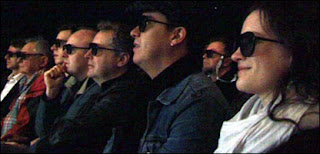For a long time 3D movies and TV shows have been a bit of a gimmick. They have been used to re-energise a tired franchise, help a film stand out at a crowded box office or to give TV viewers a glimpse of what the future might hold. But many in the 3D production industry now say that future may be closer than ever before. Film makers, technology companies and post-production outfits recently gathered at the historic Shepperton Studios to assess just how far 3D has come and where it goes next. The 3D technology gathering favour is based around stereoscopic projection. As its name implies this involves projecting two images. The viewer wears spectacles that ensure one image goes to each eye and lets the brain piece the two together to give the sense of solidity.

Stereoscopic 3D works using two lenses set the same distance apart as human eyes - about 6.3cm. Digital production systems had made it much cheaper to shoot in 3D and there's only a 20-30% cost difference on the whole process compared to 2D. Editing stereoscopic images presents particular problems because of the need to keep the two images synchronised. Care must be taken to ensure that the sequence of images matches and is not a different colour, lags a frame behind or has an artefact, such as dirt or lens flare, which the other lacks. Digital projection systems in cinemas were helping to make watching 3D movies a more pleasant experience. Digital projectors do a much better job of handling the high frame rates (144 frames per second) demanded by 3D that can preserve the details of a scene.
More information:
http://news.bbc.co.uk/1/hi/technology/7213534.stm
More information:
http://news.bbc.co.uk/1/hi/technology/7213534.stm






